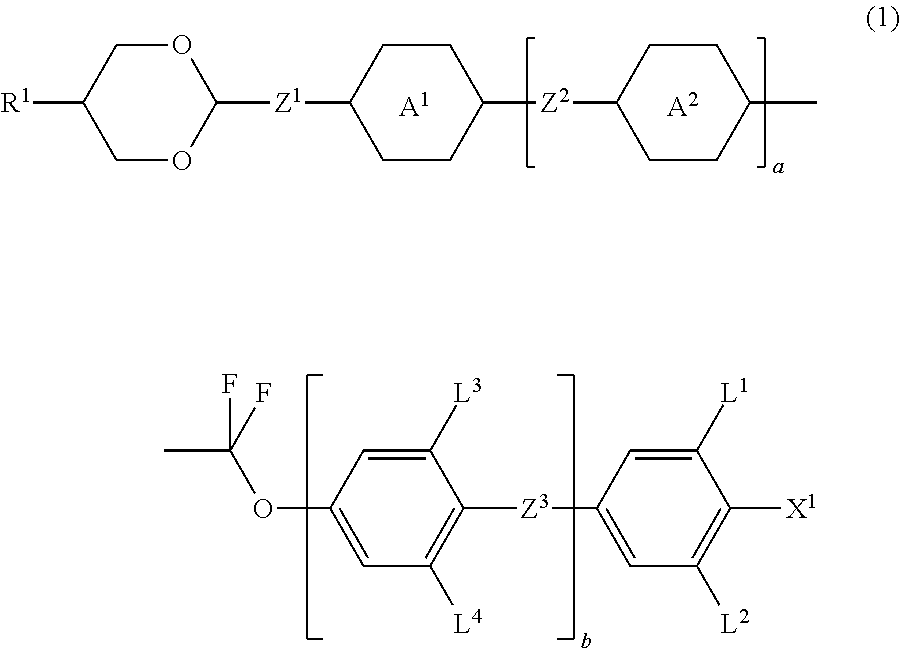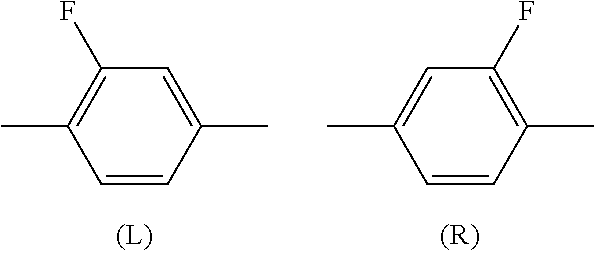Alkenyl dioxane compound, liquid crystal composition and liquid crystal display device
a technology of dioxane compound and liquid crystal composition, which is applied in the direction of liquid crystal composition, chemistry apparatus and processes, organic chemistry, etc., can solve the problems of longer service life of the device, and achieve the effects of small viscosity, high clearing point, and high heat and light stability
- Summary
- Abstract
- Description
- Claims
- Application Information
AI Technical Summary
Benefits of technology
Problems solved by technology
Method used
Image
Examples
synthesis example 1
Synthesis of Compound (No. 221)
[0147]
First Step:
[0148]Compound (221-b) was prepared from compound (221-a) with reference to JP 2013-155155 A. Then, 3,4,5-trifluorophenol (15.8 g, 0.107 mol), potassium carbonate (31.012 g, 0.224 mol) and tetrabutylammonium bromide (TBAB) (1.651 g, 5.16 mmol) were added to DMF (100 mL), and the resulting mixture was stirred at 60° C. for 1 hour. Compound (221-b) (33.6 g) was added to the solution, and the resulting mixture was stirred at 110° C. for 1 hour. The reaction mixture was returned to room temperature, poured into water (100 mL), and subjected to extraction with toluene (50 mL×3). The extract was washed with water (20 mL×2), dried over anhydrous magnesium sulfate, and concentrated under reduced pressure. The resulting residue was purified by silica gel chromatography (heptane) to obtain compound (221-c) (14.809 g; 36%) as a colorless crystal.
Second Step:
[0149]To isopropylmagnesium chloride (2.0 mol / mol THF solution; 20 mL, 0.040 mol), a THF (...
synthesis example 2
Synthesis of Compound (No. 236)
[0158]
First Step:
[0159]A mixture of 3,4,5-trifluorophenylboronic acid (47.187 g, 0.268 mol), 1-bromo-2-fluoro-4-methoxybenzene (50 g, 0.244 mol), TBAB (19.654 g, 0.0610 mol), potassium carbonate (67.410 g, 0.488 mol), 2-propanol (210 mL), toluene (210 mL) and water (60 mL) was heated and refluxed for 6 hours. The reaction mixture was poured into water (300 mL), and subjected to extraction with toluene (200 mL×3). The extract was washed with saturated brine (50 mL×2), dried over anhydrous magnesium sulfate, and concentrated under reduced pressure. The resulting residue was purified by silica gel chromatography (heptane) to obtain compound (236-a) (50 g; 80%) as a colorless crystal.
Second Step:
[0160]To a methylene chloride (300 mL) solution of compound (236-a) (50 g, 0.195 mol), boron tribromide (27.680 mL, 0.293 mol) was added dropwise at −20° C. or lower. After 30 minutes, the reaction mixture was returned to room temperature and further stirred overni...
use example 1
[0179]
V2-GB(F,F)XB(F)B(F,F)-F(No. 236)5%3-HB-O2(2-5)10%5-HB-CL(5-2)13%3-HBB(F,F)-F(6-24)7%3-PyB(F)-F(5-15)10%5-PyB(F)-F(5-15)10%3-PyBB-F(6-80)10%4-PyBB-F(6-80)8%5-PyBB-F(6-80)10%5-HBB(F)B-2(4-5)8%5-HBB(F)B-3(4-5)9%NI = 92.4° C.; η = 40.1 mPa · s; Δn = 0.185; Δε = 9.7.
PUM
| Property | Measurement | Unit |
|---|---|---|
| temperature | aaaaa | aaaaa |
| temperature | aaaaa | aaaaa |
| frequency | aaaaa | aaaaa |
Abstract
Description
Claims
Application Information
 Login to View More
Login to View More - R&D
- Intellectual Property
- Life Sciences
- Materials
- Tech Scout
- Unparalleled Data Quality
- Higher Quality Content
- 60% Fewer Hallucinations
Browse by: Latest US Patents, China's latest patents, Technical Efficacy Thesaurus, Application Domain, Technology Topic, Popular Technical Reports.
© 2025 PatSnap. All rights reserved.Legal|Privacy policy|Modern Slavery Act Transparency Statement|Sitemap|About US| Contact US: help@patsnap.com



